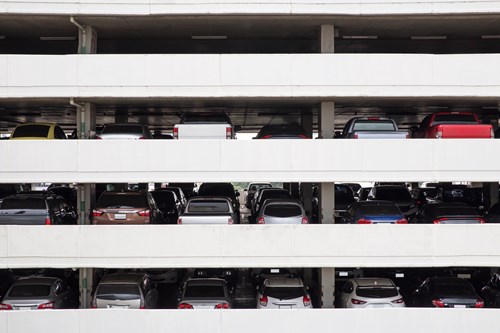
There are several types of parking facilities that cater to different needs and contexts. Parking facilities can be both indoor and outdoor, public or private. It can be a parking garage or a parking space that belongs to the property of a person’s house.
Here are some common types of parking facilities:
-
Parking Lots: Parking lots are open areas designated for parking vehicles. They are often found adjacent to buildings, shopping centers, recreational facilities, or public spaces. Parking lots can vary in size, ranging from small lots with a few parking spaces to large lots that can accommodate hundreds or even thousands of vehicles. They can be paved or unpaved and may offer different types of parking arrangements, such as perpendicular, angle, or diagonal parking.
-
Parking Garages: Parking garages, also known as multi-level parking structures or parking decks, are multi-story buildings specifically designed for parking vehicles. They provide vertical parking space utilization, allowing for a higher density of parked vehicles. Parking garages are commonly found in urban areas or locations with high parking demand, such as commercial districts, airports, or hospitals. They often feature ramps or elevators for accessing different levels and can offer both covered and uncovered parking spaces.
There are several types of parking garages:
Single-level parking garage
A single-level parking garage is a parking garage that only has only one floor.
Multilevel or multi-storey parking garage
Multilevel or multi-storey parking garages are parking garages that have multiple floors to park at. The design of a multilevel parking garage can be very different. The most common design is a garage with ramps to move from one level to another. Less common are parking garages that use lifts to go from level to level. Then there are also parking garages with robotic systems that move cars from one level to another. The floors of the parking garage can either go up, down, or both.
Underground parking garage
Underground parking facilities are located beneath buildings or public spaces. They are designed to maximize land use and maintain aesthetic appeal by keeping parking areas out of sight. Underground parking is commonly found in densely populated areas or in buildings where surface space is limited. These facilities provide protection from the elements and often offer secure parking options.
Automated parking garage
The car park operates as followed: You drive your car onto a platform in the garage. Then the automated parking system will move your car to the available parking space somewhere in the tower. The cars can be moved vertically and horizontally with the use of hydraulic or mechanical lifts. There are several benefits to a multilevel parking facility with an automated parking system. For example, you can stack more cars in a compact space because the cars are parked by robots. Also, parking spaces can be smaller because no one needs to get in or out of the vehicle and people don’t park it themselves; the robotic system doesn’t need as much space to park a car than a human does. You do need to clean the equipment every once in a while, plus at least one to four times a year someone needs to check the equipment to see if it all still works properly. The number of times for a service check depends on the equipment that is used.
-
Park-and-Ride Facilities: Park-and-ride facilities are parking areas typically located near public transportation hubs, such as train stations, bus terminals, or subway stations. They enable commuters to park their vehicles and then transfer to public transportation for their onward journeys. Park-and-ride facilities help reduce traffic congestion and provide convenient options for individuals who prefer a combination of driving and public transit for their daily commute.
-
Valet Parking: Valet parking facilities provide a higher level of convenience by offering professional parking services. In valet parking, drivers hand over their vehicles to valet attendants who park the vehicles in designated areas. This service is commonly found in hotels, restaurants, or event venues, where parking may be limited, and it allows customers to avoid the hassle of finding a parking space themselves.
-
Smart Parking Systems: Smart parking systems incorporate technology to optimize parking efficiency and improve user experience. These systems use sensors or cameras to monitor parking space availability and guide drivers to vacant spots. They may include mobile applications or digital signage to provide real-time information about parking availability, payment options, and directions. Smart parking systems help reduce traffic congestion and enhance the overall parking experience.
These are just a few examples of parking facilities, and the specific types and designs can vary depending on the location, purpose, and local regulations. The goal of parking facilities is to provide safe, convenient, and organized spaces for parking vehicles, whether in commercial areas, public spaces, or transportation hubs.








